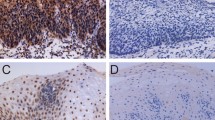Abstract
Background
A previous study conducted a transcriptome analysis of paired normal and esophageal squamous cell carcinoma (ESCC) tissue samples. The results showed that the expression of serine protease 27 (PRSS27) was perturbed in tumor samples. Hence, this retrospective study aimed to validate the prognostic significance of PRSS27 in patients with preoperative treatment for ESCC.
Methods
We enrolled 86 patients who received preoperative treatment before esophagectomy for ESCC. The expression of PRSS27 in resected ESCC and biopsy tissue samples obtained before preoperative treatment was evaluated via immunostaining, and its relationship with clinicopathological features and prognosis was analyzed.
Results
In normal esophageal mucosa tissue samples, PRSS27 was expressed in the cytoplasm of spinous cells in the suprabasal layer and basal cells in the basal layer. Of 64 resected ESCC tissue samples, 35 (54.7%) expressed PRSS27 and 29 (45.3%) did not. Moreover, ectopic nuclear expression of PRSS27 was observed. Based on multivariate analysis, PRSS27 expression in resected tumor samples was a predictor of poor prognosis. In cases in which PRSS27 expression was observed in biopsy samples, patients with PRSS27-negative resected tumors had a better postoperative prognosis than those with PRSS27-positive resected tumors.
Conclusions
PRSS27 expression in resected ESCC tissue samples is a poor prognostic factor in ESCC patients with preoperative treatment. Furthermore, conversion of PRSS27 expression from positive in biopsy samples to negative in resected tumor samples is a predictor of good prognosis in these patients. Hence, PRSS27 status is an effective tool for decision making regarding adjuvant treatment in ESCC patients.



Similar content being viewed by others
References
Then EO, Lopez M, Saleem S, et al. Esophageal cancer: an updated surveillance epidemiology and end results database analysis. World J Oncol. 2020;11(2):55–64.
Zhang M, Hu D, Wang S, et al. Clinicopathologic significance of HMGA2 expression’s correlation with prognosis of esophageal squamous cell carcinoma after Ivor Lewis esophagectomy. Minerva Chir. 2016;71(4):239–44.
Shi M, Wang Z, Song L, et al. Low expression of claudin-4: an indicator of recurrence in esophageal squamous cell carcinoma after Ivor Lewis esophagectomy? Med Oncol. 2014;31(5):951.
Natsugoe S, Okumura H, Matsumoto M, et al. The role of salvage surgery for recurrence of esophageal squamous cell cancer. Eur J Surg Oncol. 2006;32(5):544–7.
Miyata H, Sugimura K, Motoori M, et al. Clinical implications of conversion surgery after induction therapy for T4b thoracic esophageal squamous cell carcinoma. Ann Surg Oncol. 2019;26(13):4737–43.
Tachimori Y, Ozawa S, Numasaki H, et al. Comprehensive registry of esophageal cancer in Japan, 2012. Esophagus. 2019;16(3):221–45.
van Hagen P, Hulshof MC, van Lanschot JJ, et al. Preoperative chemoradiotherapy for esophageal or junctional cancer. N Engl J Med. 2012;366(22):2074–84.
Shapiro J, van Lanschot JJB, Hulshof MCCM, et al. Neoadjuvant chemoradiotherapy plus surgery versus surgery alone for oesophageal or junctional cancer (CROSS): long-term results of a randomised controlled trial. Lancet Oncol. 2015;16(9):1090–8.
Ando N, Kato H, Igaki H, et al. A randomized trial comparing postoperative adjuvant chemotherapy with cisplatin and 5-fluorouracil versus preoperative chemotherapy for localized advanced squamous cell carcinoma of the thoracic esophagus (JCOG9907). Ann Surg Oncol. 2012;19(1):68–74.
Otsubo T, Yamada K, Hagiwara T, et al. DNA hypermethyation and silencing of PITX1 correlated with advanced stage and poor postoperative prognosis of esophageal squamous cell carcinoma. Oncotarget. 2017;8(48):84434–48.
Li W, Danilenko DM, Bunting S, et al. The serine protease marapsin is expressed in stratified squamous epithelia and is up-regulated in the hyperproliferative epidermis of psoriasis and regenerating wounds. J Biol Chem. 2009;284(1):218–28.
Raman K, Trivedi NN, Raymond WW, et al. Mutational tail loss is an evolutionary mechanism for liberating marapsins and other type I serine proteases from transmembrane anchors. J Biol Chem. 2013;288(15):10588–98.
Sobin LH, Gospodarowicz MK, Wittekind C. The Union for International Cancer Control (UICC) TNM classification of malignant tumors. 7th edn. Hoboken: Wiley; 2011.
Eisenhauer EA, Therasse P, Bogaerts J, et al. New response evaluation criteria in solid tumours: revised RECIST guideline (version 1.1). Eur J Cancer. 2009;45(2):228–47.
Japan Esophageal Society. Japanese classification of esophageal cancer, 11th Edition: part II and III. Esophagus. 2017;14(1):37–65.
Zhou J, Li W, Jin T, et al. Gene microarray analysis of lncRNA and mRNA expression profiles in patients with hypopharyngeal squamous cell carcinoma. Int J Clin Exp Med. 2015;8(4):4862–82.
Zhang J, Lin H, Jiang H, et al. A key genomic signature associated with lymphovascular invasion in head and neck squamous cell carcinoma. BMC Cancer. 2020;20(1):266.
Jiang S, Zhang Q, Su Y, et al. Network-based differential analysis to identify molecular features of tumorigenesis for esophageal squamous carcinoma. Molecules. 2018;23(1):88.
Chen Y, Liao LD, Wu ZY, et al. Identification of key genes by integrating DNA methylation and next-generation transcriptome sequencing for esophageal squamous cell carcinoma. Aging (Albany NY). 2020;12(2):1332–65.
Suzuki T, Yajima S, Ishioka N, et al. Prognostic significance of high serum p53 antibody titers in patients with esophageal squamous cell carcinoma. Esophagus. 2018;15(4):294–300.
Acknowledgments
The authors thank Drs. Miwa Tamura-Nakano and Chinatsu Oyama in the NCGM EM Support Unit for their technical support in the histological analysis, and Ms. Yasuko Nozaki for her technical assistance. They would also like to thank Enago (www.enago.jp) for the English-language review. This work was supported by JSPS KAKENHI grant numbers JP15K10124, JP19K08457, and by grants from the NCGM (26-117, 29-1019 and 20A1017).
Author information
Authors and Affiliations
Corresponding author
Ethics declarations
Disclosures
Atsuko Kataoka, Kazuhiko Yamada, Teruki Hagiwara, Masayoshi Terayama, Takayuki Sugimoto, Kyoko Nohara, Toru Igari, Chizu Yokoi, and Yuki I. Kawamura have no financial or other relationships that could lead to a commercial interest.
Additional information
Publisher's Note
Springer Nature remains neutral with regard to jurisdictional claims in published maps and institutional affiliations.
Rights and permissions
About this article
Cite this article
Kataoka, A., Yamada, K., Hagiwara, T. et al. Expression Status of Serine Protease 27: A Prognostic Marker for Esophageal Squamous Cell Carcinoma Treated with Preoperative Chemotherapy/Chemoradiotherapy. Ann Surg Oncol 28, 5373–5381 (2021). https://doi.org/10.1245/s10434-020-09550-y
Received:
Accepted:
Published:
Issue Date:
DOI: https://doi.org/10.1245/s10434-020-09550-y




